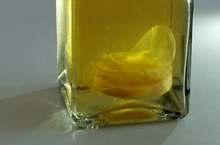Mother of vinegar
Mother of vinegar is a substance composed of a form of cellulose and acetic acid bacteria that develops on fermenting alcoholic liquids, which turns alcohol into acetic acid with the help of oxygen from the air. It is added to wine, cider, or other alcoholic liquids to produce vinegar.[1]

Mother of vinegar is also known as Mycoderma aceti, a New Latin expression, from the Greek μύκης ("fungus") plus δέρμα ("skin"), and the Latin aceti ("of the acid").[2] The naming of the bacteria has been rather fluid due to its original identification near the inception of bacteriology. Currently, the preferred naming is Acetobacter aceti.[3]
Mother of vinegar can also form in store-bought vinegar if there is some non-fermented sugar and/or alcohol contained in the vinegar. This is more common in unpasteurized vinegar. While not appetizing in appearance, mother of vinegar is completely harmless and the surrounding vinegar does not have to be discarded because of it. It can be filtered out using a coffee filter, used to start a bottle of vinegar, or simply ignored.
References
- William Theodore Brann (1889). A Practical Treatise on the Manufacture of Vinegar and Acetates, Cider, and Fruit-wines. H.C. Baird & Company. pp. 34–38. Retrieved 19 May 2016.
- Fuchs, G. [Ed.] (2006) Allgemeine Mikrobiologie. 8. ed., Thieme press, Stuttgart
- "Acetobacter aceti". Encyclopedia of Life. Retrieved 19 May 2016.